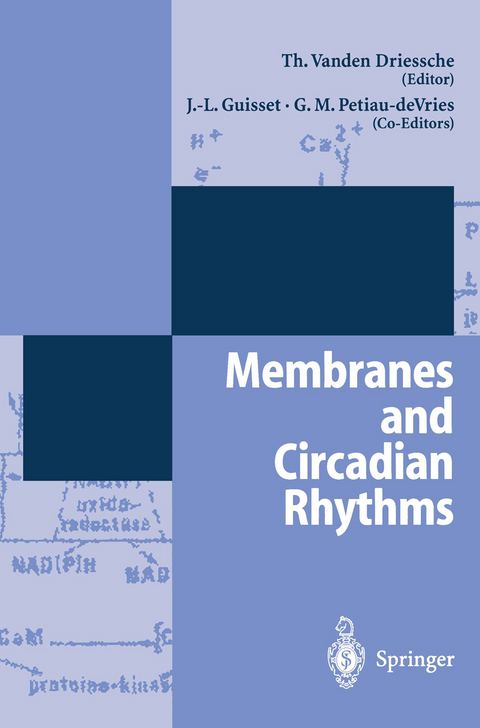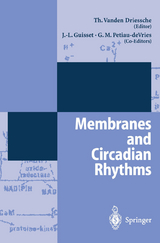Membranes and Circadian Rythms
Springer Berlin (Verlag)
978-3-540-60101-2 (ISBN)
and Overview.- Membrane Lipids and Circadian Rhythms in Neurospora crassa.- 2.1 Introduction.- 2.2 Lipids and Input.- 2.3 Lipid Metabolism and the Oscillator.- 2.4 Lipids and Output.- 2.5 Lipids and Temperature Compensation.- 2.6 Conclusion.- Membrane Glycosylation and Circadian Rhythms in Plant Systems and in Animal Normal and Transformed Systems.- 3.1 Introduction.- 3.2 Glycoproteins.- 3.3 Glycolipids.- 3.4 Proteoglycans.- 3.5 Oligosaccharins.- 3.6 Calcium.- 3.7 Tumors.- 3.8 Conclusion.- From Ultradian Biochemical Oscillations to Circadian Rhythms.- 4.1 Introduction.- 4.2 Biochemical Oscillations.- 4.3 Circadian Oscillations of the period Protein (PER) in Drosophila.- 4.4 Concluding Remarks.- Cross-talk Between Clocks: Regulation of Cell Division Cycles by Circadian Oscillators.- 5.1 Introduction.- 5.2 Coupling between Oscillator and Cell Cycle: Role of Cyclic AMP.- 5.3 Problems and Prospects: Interface with the Cyclin Clock.- Membrane Transport and Oscillations in Plants.- 6.1 Introduction.- 6.2 The Plasma Membrane H+-ATPase.- 6.3 Ion Channels.- 6.4 Temporal Oscillations.- 6.5 Spatial Oscillations.- 6.6 Conclusion.- Circadian Rhythms and Photoperception in Plants: The Role of Red Light and Blue Light.- 7.1 Introduction: plants and light (with exclusion of photo-synthesis).- 7.2 Phytochrome.- 7.3 Blue light.- 7.4 Blue light perception and the plasma membrane.- 7.5 Is there a role for free flavins in blue light perception?.- 7.6 Conclusion.- Temporal Variations in Tissular and Plasma Protein Binding of Drugs with Special Reference to their Erythrocyte Penetration as Mechanisms Involved in Chronopharmacological Effects.- 8.1 Introduction.- 8.2 Temporal variations in plasma protein binding of drugs.- 8.3 Temporal variations in tissular drug binding.- 8.4 Penetration of drugs into erythrocytes as a tool for the study of temporal variation in the passage of drugs through membranes.- 8.5 Chronopharmacological mechanisms at receptor sites.- 8.6 Conclusions.- Photosynthesis: a Post-Transcriptionally Regulated Circadian Rhythm in Some Lower Eukaryotes.- 9.1 Introduction.- 9.2 Circadian Rhythmicity Regulated at Post-Transcriptional Level.- 9.3 The Support of the Circadian Rhythm in Photosynthesis in three Unicellular Organisms.- 9.4 Final Remarks and Conclusions.- Circadian Rhythms, Membranes and Susceptibility to Environmental Factors.- 10.1 Introduction.- 10.2 Experimental Evidence.- 10.3 Conclusions.- The Plasma Membrane of Acetabularia: an Integrating Function Regulated by Circadian Rhythmicity.- 11.1 Introduction.- 11.2 Basic Rhythmic Activity of the Plasma Membrane.- 11.3 The Plasma Membrane Photoreceptor.- 11.4 The Plasma Membrane NADP(H)-Oxido-Reductase.- 11.5 The Peroxidase/Ascorbic Acid System.- 11.6 The Phytohormone Receptors.- 11.7 The Insulin Receptor. Its Role in Acetabularia.- 11.8 Discussion and Conclusion.
| Erscheint lt. Verlag | 11.10.1995 |
|---|---|
| Mitarbeit |
Stellvertretende Herausgeber: Jean-Luc Guisset, Ghislaine M. Petiau-de Vries |
| Zusatzinfo | XII, 226 p. 4 illus. |
| Verlagsort | Berlin |
| Sprache | englisch |
| Maße | 155 x 235 mm |
| Gewicht | 371 g |
| Themenwelt | Medizin / Pharmazie ► Medizinische Fachgebiete ► Pharmakologie / Pharmakotherapie |
| Medizin / Pharmazie ► Pharmazie | |
| Naturwissenschaften ► Biologie ► Zellbiologie | |
| Schlagworte | Cell • cell cycle • cell division • cell division cycle • cell membrane • Chloroplast • Endoplasmatisches Reticulum • glycoprotein • Membrane • Metabolism • photoreceptors • Phytohormon • Plasma membrane • proteins • Regulation • signal transduction • Tagesrhythmus • transcription • Tumors • Zellmembran |
| ISBN-10 | 3-540-60101-5 / 3540601015 |
| ISBN-13 | 978-3-540-60101-2 / 9783540601012 |
| Zustand | Neuware |
| Haben Sie eine Frage zum Produkt? |
aus dem Bereich




